“Taking it to the next level” is cliché.
So is the phrase “he/she/it opened a lot of doors for me.”
But people still reach for these phrases regardless, and there’s a reason for that.
These phrases reflect an intuitive understanding of transitions: that there’s always a threshold to cross.
Boundaries define an area, environment, or world. Movement past boundaries necessitates movement through openings in those boundaries — or though portals, if you will.
So where there is change, there are portals, or so our subconscious minds expect.
But all too often, businesses fail to meet our subconscious expectation for portals.
Businesses usually want to transition shoppers from thinking one way about a product or service (price sensitive) to another way of thinking, typically one that elevates shared values, big-picture performance, and total experience above price.
The goal is to move shoppers from an objective, consumer-reports mindset to an enthusiast’s mindset.
And yet people don’t just snap from one state of mind into another; there has to be a transition and a portal to mark that transition.
Put plainly: if you’re selling premium products or experiences, you need to understand the power of portals.
Fantasy Writers Understand Portals
When it comes to portals, perhaps the best people to study are fantasy writers, who have always intuitively sensed the need for portals between worlds:
-
- C.S. Lewis had his Wardrobe.
- J.K. Rowling had her Platform 9 3/4s,
- L. Frank Baum had Dorothy ride her twister, and
- The Wachowski Brothers gave Neo his red pill (among other portals).
Enter The Picture Book Powerhouse of Portals
 But some of the most intense and easily observed stacking of portals I’ve come across take place in a children’s picture book: Skippyjon Jones, by Judy Schachner.
But some of the most intense and easily observed stacking of portals I’ve come across take place in a children’s picture book: Skippyjon Jones, by Judy Schachner.
And what follows is my breakdown of Portal Stacking in Skippyjon Jones. And to start, let me give you a bit of set-up…
Skippyjon Jones is a young Siamese Cat who likes to pretend that he’s really some other animal.
The story starts with him pretending to be a bird, much to his mother’s dismay. So Skippyjon’s mom sends him to his room for a little time out.
And that’s when ol’ Skippyjon begins his transformation into the great sword-fighting Chihuahua, El Skippito Friskito. A transformation involving portals galore.
First, Skippyjon starts bouncing on his bed, with the bouncing symbolically equivalent to flight.
Then, during that flight, Skippyjon Jones encounters his first portal:
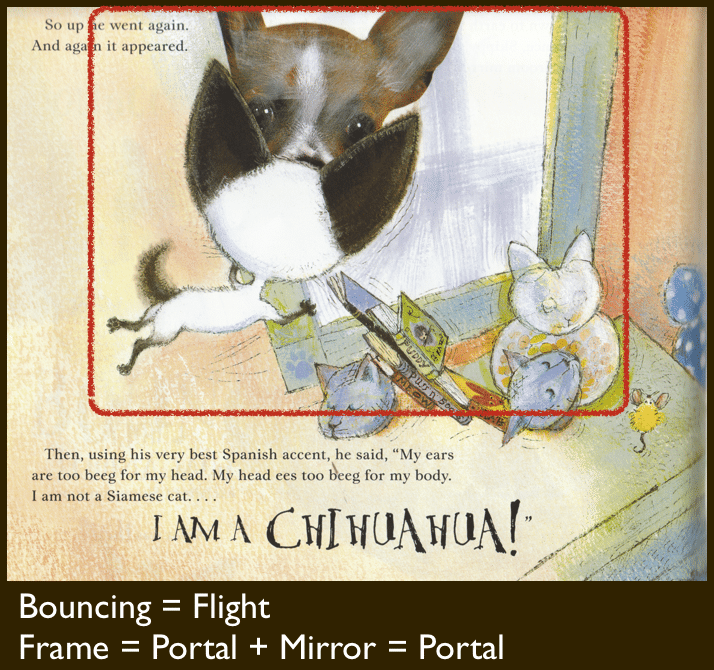
Literature is rife with the notion of mirrors as portals.
And Skippyjon’s midflight glimpse into his mirror reveals his hidden chihuahua nature.
A nature which is amplified through the donning of a Lone Ranger style mask by the little kitty. Skippyjon literally becomes invested in the identity.
Then the story cuts to Skippyjon’s mother and sisters watching TV downstairs, talking about Skippyjon’s time out.
But when the book cuts back to Skippyjon Jones, we’re transported into the room, but brought outside his room and forced to look in through — you guessed it — a portal:
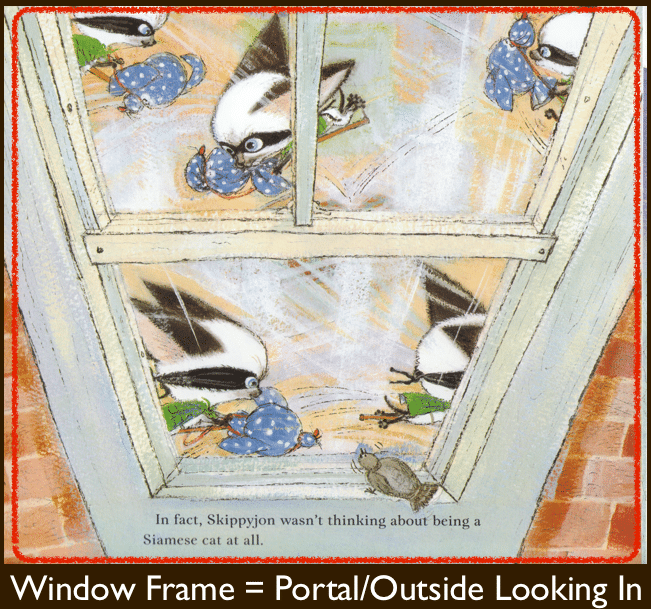
We’re outside seeing Skippyjon objectively as a masked kitty racing around his room like a freak.
And the half-conscious expectation is that when we move inside, we’ll transition from outside to inside in more ways than one, moving from an objective to a subjective understanding, so that we will start to see what Skippyjon/El Skippito Friskito sees.
Still, the reader is further prompted to engage in Skippyjon’s whimsy by yet another portal transition, this time from the room to the closet:
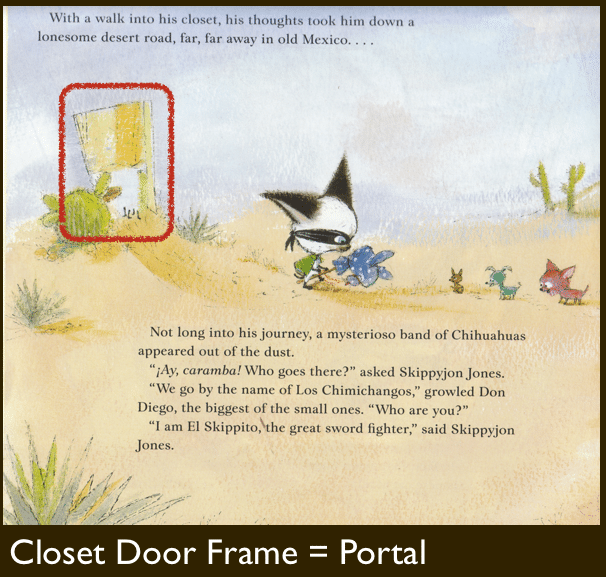
So we have a double-portal transition, from outside the room to inside, and from inside the well-lit room to inside the dark closet, wherein the magical realm of imagination rules, and where Skippyjon Jones, the Siamese cat, fully becomes El Skippito Friskito, the great sword-fighting Chihuahua.
But still, if Skippyjon is to fight something truly monstrous, he might have to cross yet another portal within the imaginary story, before he is to face the monster.
And so he does, as Skippito and his band of Chihuahua friends take a nap, using sleep as the ultimate portal to dreams…
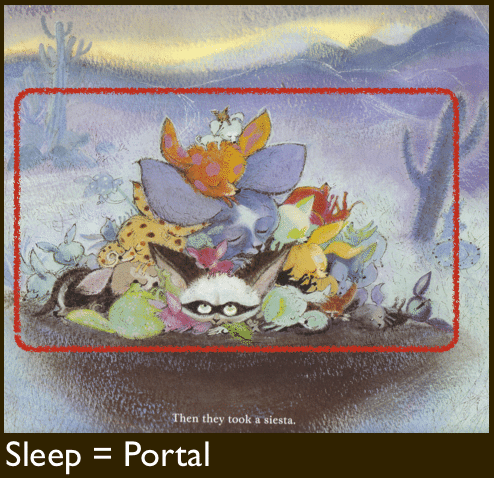
And that’s when the adventures really begin.
Until the conclusion of Skippyjon’s imaginative adventure, when El Skippito is blown back through the portal/closet door, and back to the everyday reality of his mother and sisters.
Portal crossing in; portal crossing out.
So why is this important for the book?
It makes the difference between watching a kitten dream something silly, and being emotionally pulled along with him into his dreams.
All those portals really help readers (of all ages) “get into” the story.
Yes the story itself is delightful, and yes, the author (Judy Schachner) does a wonderful job making the book a blast to read.
But I can’t help but think the brilliant use of portals has more than a little do with the books critical praise and widespread popularity.
And in case you think I’m reading too much into this, take a look at the Official Skippyjon Jones Website’s entrance page:
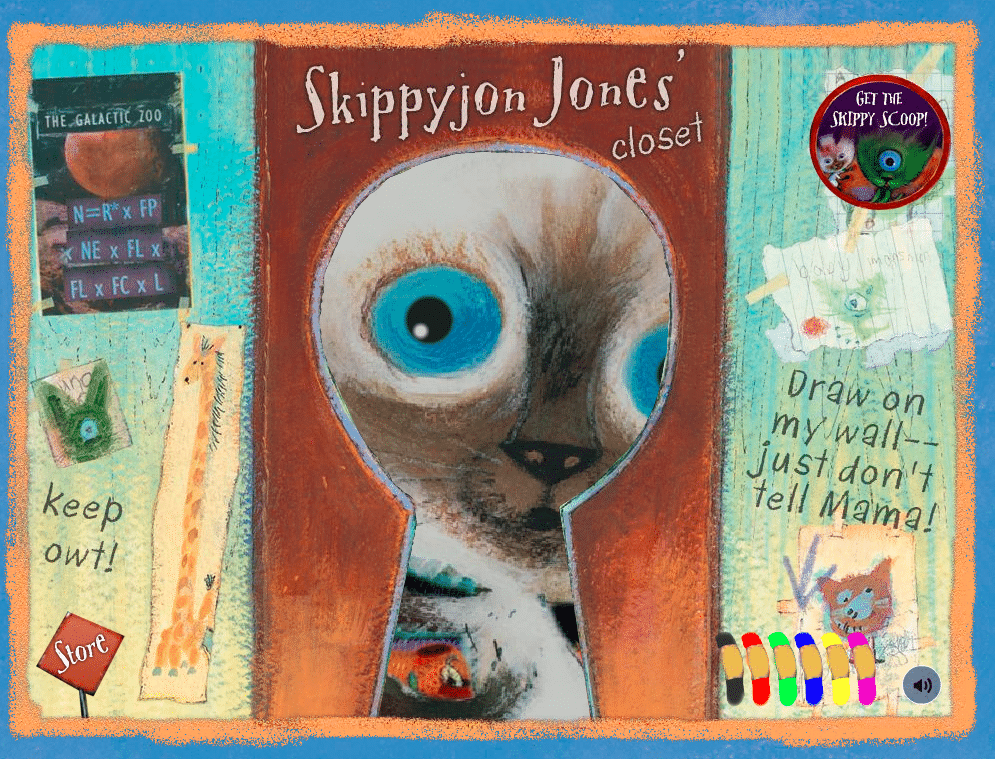
Anyone want to guess what happens when you click to enter? Go ahead and try it!
So, that’s cool and all, but how can you use it for your business? We’ll get into that with our next post on portals.
But for now, let me just give Judy Schachner’s book a hardy plug for all those with young kids out there.
It won the E.B. White Read Aloud Award because it’s both a blast for the parents to read and a delight for kids to listen to. Highly recommended.
And who knows, you might learn something too…
- Getting a Foot in the Door — Of Perception - November 27, 2025
- What Digital Superstars Know About Offline Advertising - November 17, 2025
- Unmistakable: A Tale of Two Boots and Branding Done Right - November 8, 2025
